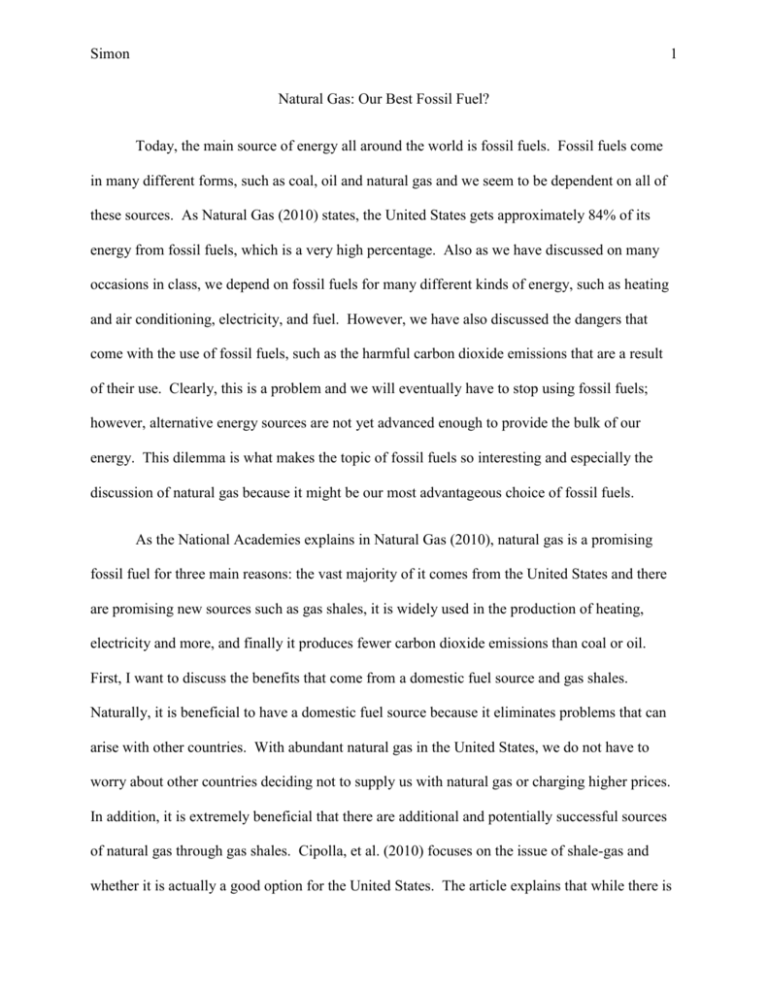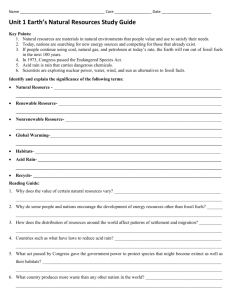File
advertisement

Simon 1 Natural Gas: Our Best Fossil Fuel? Today, the main source of energy all around the world is fossil fuels. Fossil fuels come in many different forms, such as coal, oil and natural gas and we seem to be dependent on all of these sources. As Natural Gas (2010) states, the United States gets approximately 84% of its energy from fossil fuels, which is a very high percentage. Also as we have discussed on many occasions in class, we depend on fossil fuels for many different kinds of energy, such as heating and air conditioning, electricity, and fuel. However, we have also discussed the dangers that come with the use of fossil fuels, such as the harmful carbon dioxide emissions that are a result of their use. Clearly, this is a problem and we will eventually have to stop using fossil fuels; however, alternative energy sources are not yet advanced enough to provide the bulk of our energy. This dilemma is what makes the topic of fossil fuels so interesting and especially the discussion of natural gas because it might be our most advantageous choice of fossil fuels. As the National Academies explains in Natural Gas (2010), natural gas is a promising fossil fuel for three main reasons: the vast majority of it comes from the United States and there are promising new sources such as gas shales, it is widely used in the production of heating, electricity and more, and finally it produces fewer carbon dioxide emissions than coal or oil. First, I want to discuss the benefits that come from a domestic fuel source and gas shales. Naturally, it is beneficial to have a domestic fuel source because it eliminates problems that can arise with other countries. With abundant natural gas in the United States, we do not have to worry about other countries deciding not to supply us with natural gas or charging higher prices. In addition, it is extremely beneficial that there are additional and potentially successful sources of natural gas through gas shales. Cipolla, et al. (2010) focuses on the issue of shale-gas and whether it is actually a good option for the United States. The article explains that while there is Simon 2 an abundance of shale in the United States, this technique might not be economically ideal. Cipolla, et al. (2010) explains that in order to reach the gas reservoir, we would need complex fracture networks and that gas recovery could be a problem. Based on this evidence, shale-gas is not the most efficient, but it could be a solution to replace the use of other fossil fuels which cause more harm for the environment. Next, natural gas plays a large role in providing us with many different energy sources. Natural Gas (2010) states that natural gas provides heat to at least half of the homes in the United States and it is also used to generate 21% of our electricity. These are very high numbers and they prove how important natural gas is. In addition to providing heat and electricity, natural gas is used to produce transportation fuel (Venkatesh, et al., 2011). As someone who came into this class knowing very little about energy and its sources, I would have never guessed that natural gas plays such an important role in energy production. This is part of the reason why I chose to write about natural gas. Finally, natural gas is a very interesting and useful fossil fuel because it is significantly cleaner that coal, as it produces few carbon dioxide emissions. According to the National Academies in Natural Gas (2010), natural gas produces nearly half of the carbon dioxide emissions that coal produces. This is a very big difference that can have a big effect on keeping our environment clean. However, while it is wonderful that the burning of natural gas releases less harmful carbon dioxide emissions, there are also negative environmental effects that come with the burning of natural gas. As Burnham et al. (2011) explains, the burning of natural gas produces methane, which is also harmful to the environment. However, the main question is whether the benefits of less carbon dioxide from the use of natural gas outweigh the production of methane (Burnham, et al., 2011). Simon 3 Clearly, while natural gas is a commonly used fossil fuel and it has many positive characteristics, it also has negative characteristics. This is what makes natural gas such an interesting topic. Natural gas is clearly a good resource because it is domestic, and it produces reduced carbon dioxide emissions. However, does the decrease in carbon dioxide emissions outweigh the harmful methane emissions? This is a question that scientists will have to consider. Regardless, it is clear that natural gas is an abundant resource in our country and it provides us with many of our energy demands. It seems as though natural gas might be our most advantageous choice of fossil fuels until alternative energy sources are perfected. Simon 4 References Burnham, A., Han, J., Clark, C. E., Wang, M., Dunn, J. B., & Palou-Rivera, I. (2011). Life-cycle greenhouse gas emissions of shale gas, natural gas, coal, and petroleum. Environmental science & technology, 46(2), 619-627. Cipolla, C., Lolon, E., Erdle, J., & Rubin, B. (2010). Reservoir modeling in shale-gas reservoirs. SPE Reservoir Evaluation & Engineering, 13(4), 638-653. Natural gas. (2010). In What You Need to Know About Energy. Retrieved March 23, 2013, from http://needtoknow.nas.edu/energy/energy-sources/fossil-fuels/natural-gas/ Venkatesh, A., Jaramillo, P., Griffin, W. M., & Matthews, H. S. (2011). Uncertainty in life cycle greenhouse gas emissions from United States natural gas end-uses and its effects on policy. Environmental science & technology, 45(19), 8182-8189.






